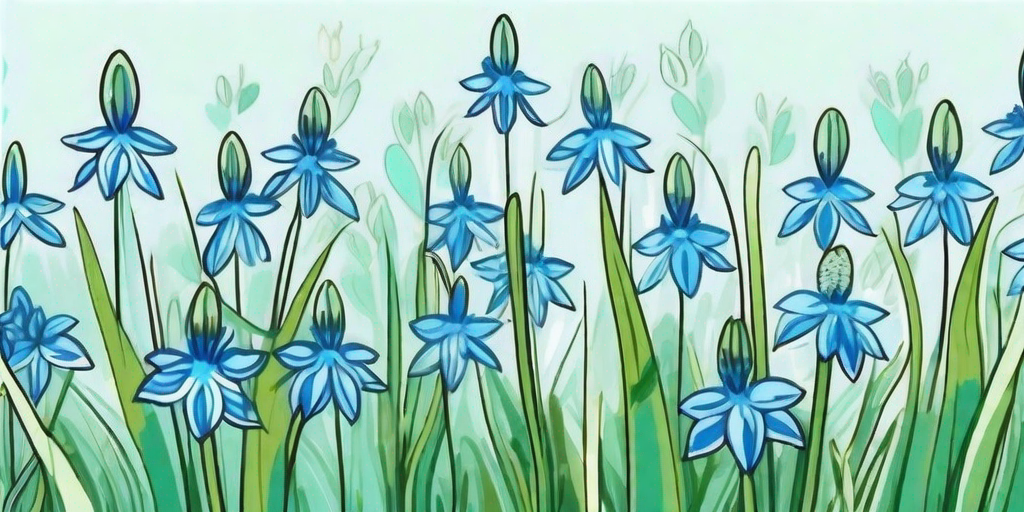
As the frosty grip of winter loosens and the first signs of spring begin to emerge, there's a particular blue beauty that steals the show in gardens and parks around the world. We're talking about the Siberian Squill, a cheeky little bulbous perennial that's as hardy as a Siberian winter and as delightful as a spring morning.
Understanding the Siberian Squill
The Siberian Squill, scientifically known as Scilla siberica, is a charming little plant that's native to southwestern Russia, the Caucasus, and Turkey. This plant is a member of the Asparagaceae family, which is a fancy way of saying it's related to asparagus. But trust us, you wouldn't want to put this one on your dinner plate!
What makes the Siberian Squill so special is its vibrant blue flowers that bloom in early spring. These flowers are a sight for sore eyes, especially after a long, dreary winter. They're like little blue fireworks that explode into life, adding a splash of color to the landscape.
The Anatomy of a Siberian Squill
The Siberian Squill is a small plant, typically growing up to 15 cm tall. It has narrow, lance-shaped leaves that are about as sharp as a comedian's wit. The flowers are star-shaped and come in a striking shade of blue, with a white center that's as pure as the driven snow.
Each plant produces one to three flowers on a slender stalk. The flowers hang down like little blue lanterns, lighting up the garden with their vibrant color. The petals are slightly curved, giving the flowers a unique, bell-like appearance.
How to Grow Siberian Squill
Now that you're head over heels for this blue beauty, you're probably wondering how you can grow it in your own garden. Well, you're in luck! The Siberian Squill is a low-maintenance plant that's perfect for beginner gardeners. It's as easy to grow as it is easy on the eyes.
Here's a step-by-step guide on how to grow Siberian Squill:
- Choose a location with well-draining soil and partial to full sun.
- Plant the bulbs in the fall, about 7 cm deep and 7 cm apart.
- Water the bulbs after planting, and then regularly throughout the growing season.
- Watch as your garden transforms into a sea of blue in the spring!
Tips for Growing Siberian Squill
While the Siberian Squill is a relatively easy plant to grow, there are a few tips and tricks that can help you get the most out of your gardening efforts. Here are a few nuggets of wisdom from seasoned gardeners:
- Plant the bulbs in clusters to create a more dramatic display.
- Don't be alarmed if the leaves turn yellow and die back after flowering. This is a normal part of the plant's life cycle.
- Leave the bulbs in the ground after the flowers have faded. They'll come back year after year, spreading joy and color in your garden.
FAQs about Siberian Squill
Still have questions about this delightful plant? Don't worry, we've got you covered. Here are some of the most frequently asked questions about Siberian Squill:
- Is Siberian Squill invasive?
- While Siberian Squill can spread quickly and cover a large area, it's not considered invasive in most areas. However, it's always a good idea to check with your local extension service before planting.
- Can Siberian Squill grow in shade?
- Yes, Siberian Squill can tolerate shade, but it prefers a location with at least some sun. The more sun it gets, the more flowers it will produce.
- Is Siberian Squill deer resistant?
- Yes, Siberian Squill is deer resistant. It's one of the few spring bulbs that deer tend to avoid, making it a great choice for gardens that are frequented by these four-legged visitors.
Conclusion
There you have it, everything you need to know about the Siberian Squill, the blue delight of spring. This charming plant is a joy to grow and a pleasure to behold. It's the perfect way to welcome spring and add a splash of color to your garden.
So why not give it a try? Plant some Siberian Squill bulbs this fall and watch as your garden transforms into a sea of blue next spring. It's a sight you won't want to miss!















